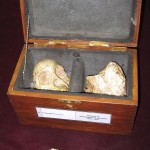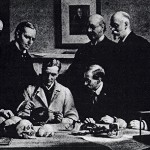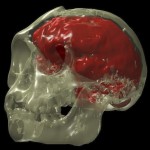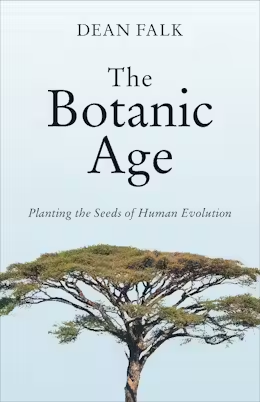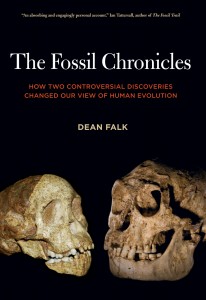
The Fossil Chronicles: How Two Controversial Discoveries Changed Our View of Human Evolution
Awards
Among the Best Books of 2011 • AAAS (American Association for the Advancement of Science) • Science Books & Films: Your Online Guide to Science Resources
About the Book
Two discoveries of early human relatives, one in 1924 and one in 2003, radically changed scientific thinking about our origins. Dean Falk, a pioneer in the field of human brain evolution, offers this fast-paced insider’s account of these discoveries, the behind-the-scenes politics embroiling the scientists who found and analyzed them, and the academic and religious controversies they generated. The first is the Taung child, a two-million-year-old skull from South Africa that led anatomist Raymond Dart to argue that this creature had walked upright and that Africa held the key to the fossil ancestry of our species. The second find consisted of the partial skeleton of a three-and-a-half-foot-tall woman, nicknamed Hobbit, from Flores Island, Indonesia. She is thought by scientists to belong to a new, recently extinct species of human, but her story is still unfolding.
Falk, who has studied the brain casts of both Taung and Hobbit, reveals new evidence crucial to interpreting both discoveries and proposes surprising connections between this pair of extraordinary specimens.
Purchase The Fossil Chronicles: How Two Controversial Discoveries Changed Our View of Human Evolution at UC Press.
Book Reviews
October 6, 2011 • “Craniums with Clout” by Henry Gee • Nature • VOL 478 • Books & Arts Section
We have all seen the canonical parade of apes, each one becoming more human. We know that, as a depiction of evolution, this line-up is tosh. Yet we cling to it. Ideas of what human evolution ought to have been like still colour our debates.
Palaeoanthropologist Dean Falk debunks some modern myths in her brilliant book, The Fossil Chronicles, by comparing the case histories of two famous fossils. A career spent teasing meaning from the brain casts of fossil hominins (creatures more closely related to Homo sapiens than to chimpanzees) has led Falk into the debate on the cognitive abilities of Homo floresiensis. This dwarfed hominin — nicknamed the Hobbit — lived on the Indonesian island of Flores between approximately 95,000 and 14,000 years ago, and was discovered in 2003 (see Nature 431, 1055–1061; 2004). Falk also describes Raymond Dart’s 1924 discovery in South Africa of a juvenile skull of Australopithecus africanus, the Man-Ape of South Africa, and locates an unpublished manuscript by Dart on the find that chimes with her views.
Almost every time someone claims to have found a new species of hominin, someone else refutes it. The species is said to be either a member of Homo sapiens, but pathological, or an ape. Brickbats of the first kind were levelled recently at H. floresiensis — that it wasn’t a genuine species, but a modern human suffering from one of several kinds of microcephaly or from cretinism. But they had also been aimed at Neanderthal Man, discovered back in 1856, and thought by some to be the remains of a Mongolian Cossack from the Napoleonic wars. Accusations of apishness were aimed at A. africanus, described by Dart in these pages in 1925; and at Sahelanthropus tchadensis, nicknamed Toumaï, a very primitive putative hominin from Chad, discovered in 2001.
Dart’s original paper on A. africanus was, it is true, long on waffle and short on substance. But the reason that this small-brained, possibly erect-walking creature took two decades to be accepted as a hominin was that researchers were in thrall to the idea that the expansion of the human brain came first, before the adoption of a fully erect gait. This preconception was supported by the discovery of the large-brained, ape-jawed Piltdown Man in 1912. The fact that it took 40 years to expose Piltdown as a fraud is a mark of how deeply rooted such prejudices can be.
Falk describes her work refuting the idea that the small brain of the Hobbit implies the creature might have had a congenital disorder of brain growth. She shows that its brain most resembled that of Homo erectus, another antique hominin, and was developed in areas associated with cognitive abilities that would have supported making the simple tools with which its fossils are associated. Yet the Hobbit has a closer resemblance in its general anatomy to Australopithecus, suggesting — again contrary to preconception — that hominins emerged from Africa much earlier than thought.
The best parts of the book are those in which Falk traces the history of Dart. The Australian anatomist was exiled to South Africa by his mentor at University College London, Grafton Elliot Smith. In Africa, chance threw in his way the brain cast and skull of a juvenile hominin: a creature he named A. africanus. After publishing his Nature paper, Dart was critically mauled by the London establishment — notably the ‘Piltdown Committee’ who believed in the fake fossil — and he almost deserted palaeoanthropology, devoting his energies to building up capacity at the then-fledgling University of the Witwatersrand in Johannesburg.
Almost, but not quite. Falk’s investigation of Dart’s papers at Witwatersrand has brought to light a monograph on A. africanus that Dart never published. In 1929 he sent it to Elliot Smith to submit to the Royal Society in London, but it was rejected, presumably on the basis of reports by the Piltdown Committee. Falk reveals that Dart had come to similar conclusions about the cognitive capacity of A. africanus as she has with H. floresiensis, providing circumstantial evidence for her link between Australopithecus and the Hobbit, and for an earlier African diaspora. Brains might be small, but they can still pack a punch.
Falk’s book is worth reading just for the unearthing of this otherwise lost manuscript, vital to the history of palaeoanthropology. That it sparkles with scholarship and wit is icing on the cake.
October 8, 2011 • “Bones That Tell a Tale” by Brian Switek • The Wall Street Journal • Bookshelf Section
Has the discovery of a fossil human ever been announced without stirring an immediate controversy? For more than 150 years, revelations of a new species of our prehistoric kin have sent scientists into a tizzy about the meaning of the news. Just last month, Science magazine trumpeted the existence of two-million-year-old, human-like fossils (Australopithecus sediba) found in a South African cave. But no one has yet agreed on how this proposed ancestor of ours actually relates to us.
In the annals of paleoanthropology—the study of ancient humans—two disputes stand out: the discovery of the “Taung child” in 1925 and the revelation in 2004 of fossil “hobbits” on Flores Island in Indonesia. The announcements of both species challenged commonly held hypotheses about human history. The discovery of the Taung child in South Africa frustrated anthropologists who believed that Asia was the cradle of humanity. The hobbit news stirred an acrimonious debate on several fronts: How many human species existed before Homo sapiens took off and others in the Homo genus died away? When did humans first leave Africa? And why are some anthropologists so cranky?
Not surprisingly, Dean Falk settles on these two episodes, in “The Fossil Chronicles,” to illustrate the highly contentious nature of paleoanthropology. The book is part historical drama, part neurological crash course and part autobiography (the author is a Florida State University paleoneurologist). The combination is refreshing. There are plenty of books about finding fossil humans and about the neurological basis for “what makes us human.” But Ms. Falk has brought the subjects together with a personal touch, producing an appealing narrative that compares an old debate (the Taung child) with a newer one (hobbits) to gauge how much—or how little—paleoanthropology has changed in the past century. She notes that paleonathropologists in the past were “every bit as adamant and defensive about their favored evolutionary theories as some who practice in the field today.”
When the skull of the Taung child was found by the Australian anthropologist Raymond Dart, the fossil was dismissed by influential British anthropologists as irrelevant to human history. Sir Arthur Keith said that Dart’s identification of the Taung child as one of our close relatives was “preposterous.” “The skull,” he confidently asserted, “is that of a young anthropoid ape,” and many of his colleagues agreed. Twenty-five years passed before additional discoveries of other fossils spurred experts to welcome the kid into our family tree, though the species is not regarded as one of our direct ancestors.
The Taung story has been told many times, but Ms. Falk brings some new perspective by discussing how, by making a cast of the interior of the small skull, it is possible to study how human or ape-like the brain inside might have been. In her estimation, experts misinterpreted some of the intricate crevices and lumps on this brain cast, leading to the mistaken assumption that a feature called the lunate sulcus was in a position similar to ours, when the lunate sulcus was actually in a position more similar to nonhuman apes. This contradicted the previously held hypothesis that the back of the brain in the Taung specimen was already becoming like our own. She published that assessment in 1980, and just as Raymond Dart’s announcement drew an initially negative response, Ms. Falk’s sparked much debate about the pattern of human brain development. In a published response, anthropologist Ralph Holloway called Ms. Falk one of the “few practicing ‘phrenologists’ ” for her use of different analytical techniques than his own. Ms. Falk was shocked that her work was compared with that of 19th-century pseudoscience, and her response to Mr. Holloway kicked off a long-running technical debate about the brains of our petrified kin.
Ms. Falk’s expertise as an interpreter of fossil brains also drew her into the hobbit controversy after archaeologist Michael Morwood and an international team described, in 2004, the diminutive remains of a previously unknown species of human who lived on Flores Island in the Pacific sometime between 12,000 and 38,000 years ago. The humans—best known from a partial female skeleton dubbed Homo floresiensis—became affectionately known as hobbits for their small size and big feet. (The “Lord of the Rings” movies were hot at the time.)
But not everyone was convinced that a new human species had been found. Some anthropologists dismissed the specimens as simply showing evidence of a miserable community afflicted by microcephaly, Laron syndrome, cretinism or other ailments that might produce similar physical features. Ms. Falk expertly and persuasively knocks down each of these alternative hypotheses, a discussion informed by her own work on the fossils. And she focuses our attention on a more perplexing problem. Who were the hobbits’ ancestors? No one is quite sure. The Flores inhabitants might have been descendants of a far-flung Homo erectus population before it went extinct, or their archaic traits might indicate that human species were leaving Africa earlier than previously thought.
“The Fossil Chronicles” is sometimes a touch too technical for the general reader. In one section, Ms. Falk declares: “Dart had mistakenly identified the lambdoid suture of the skull that had been imprinted on Taung’s endocast as the lunate sulcus!” Readers who have not taken Neurology 101 may find it difficult to share the author’s enthusiasm. But the book is rewarding precisely because Ms. Falk is steeped in her subject and is unflinching in her depiction of how petty and acrimonious the study of human origins can be. The Taung-child controversy was not the first of its kind, and the hobbit debate will not be the last. As new discoveries stir fresh clashes, we’ll need writers and researchers like Ms. Falk to pull back the curtain on the complicated inner workings of scientific discovery.
—Mr. Switek is the author of “Written in Stone: Evolution, the Fossil Record, and Our Place in Nature.”
October 5, 2011 • “Evolutionary Clues from Ancestors’ Brains?” • NewScientist • CultureLab Section
Sometime in the distant past our ancestors’ brains grew sophisticated enough to ponder life’s big questions. In this book, Dean Falk explains how the study of those ancient brains – or at least, the impressions they left in the skulls they occupied – may help to provide an answer to one of the biggest questions: where did we come from?
Falk was a key member of the team that studied the brain impression of Homo floresiensis, or the “Hobbit”, discovered in Indonesia in 2003. She is now central to an ongoing controversy over whether that brain belonged to a distant relation of our species – Falk’s preferred conclusion – or a modern human with a developmental disorder.
It’s not the first time old brains have caused controversy. The book begins with an account of the discovery of a more ancient hominin, Australopithecus africanus, in 1920s South Africa. Its ape-like brain but human-like limbs were a poor fit for the consensus view at the time: that human evolution began with the brain. Falk laments that it took years to upend that consensus, which largely grew around the big-brained “Piltdown man”, found in England in 1912 and later revealed to be a hoax.
The most exciting parts of the book are when Falk describes her role in the Hobbit debate. Though she claims to be disappointed that discussions over arguably the most important human fossil find in decades are largely fixated on whether it is a valid new species, the relish with which she describes the debate suggests she has enjoyed every moment.
For more reviews, visit Mullane Literary Associates
From the Book’s Introduction
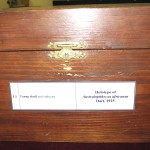
The famous Taung fossil (Australopithecus africanus) is part of the collection at the University of Witwatersrand, in Johannesburg, south Africa.
No subject provokes as much curiosity, argument, and dogma as the origin of humans. From the child who asks, “Where did I come from?” to religious leaders who maintain traditional beliefs about creation and our role in the cosmos, human origins is a topic of keen concern. Most, if not all, cultures have origin stories. So do the scientists who study human evolution, which is one reason why our academic field, known as paleoanthropology, can be particularly acrimonious. This is nothing new. In the late nineteenth century, naturalists staunchly defended their particular theories about human origins, despite contradictory finds that were beginning to accumulate in the fossil record. In this book, I focus on two pivotal and controversial discoveries that redefined how both the public and scientists viewed human evolution, one from the 1920s and another that was unearthed less than a decade ago. Each is analyzed within its contemporary milieu, including the state of scientific knowledge about human evolution, the social undercurrents related to religious fundamentalism, and the academic politics that pervade investigations of our past (paleopolitics). The two discoveries are compared with each other and interpreted within a wider framework that incorporates other finds, including the infamous Piltdown fraud.
My aim is to portray the twists, turns, competitiveness, and passions that have always characterized research on human origins. If readers feel some of the excitement and drama of pursuing questions about what made us human and the thrill of refining the tentative answers in light of newly discovered fossils, I will have achieved my goal in this book. If they also glean something about scientists as people (warts and all) and the nature of their ongoing disputes with religious fundamentalists, all the better.
I have seen colleagues almost come to fisticuffs over clashing opinions, and my own ideas have been subjected to intense, sometimes unpleasant, scrutiny. The reason my work has drawn such attention is that I study the evolution of the human brain. Our brains, after all, set us apart from other animals; they are the physical locus of all of the cognitive, neurological, and emotional traits that make us human. I think this is why the subfield of paleoanthropology that focuses on brain evolution, called paleoneurology, is especially contentious.
Casts from the inner braincases of our ancestors (known as endocasts) provide a physical record of this most important human organ and have been crucial for interpreting several fossils from the human family, including the two exceptional discoveries discussed in this book. The first, called Taung, was unearthed in South Africaby the Australian anatomist Raymond Dart in the 1920s and is probably the world’s most famous fossil. It consists of a little face, jaw, and endocast from a child and was the first specimen discovered from what is now recognized as an exceedingly important group of early human relatives, the australopithecines. The Taung specimen was announced in the journal Nature in 1925, just five months before the Scopes monkey trial would challenge the theory of evolution inDayton,Tennessee. Although the announcement of Taung made headlines around the world, Dart was then subjected to over two decades of criticism from both religious fundamentalists and colleagues who doubted his claims about Taung’s importance for human origins.
Part of the suspicion about Taung was due to the prior discovery of the so-called Piltdown Man, which included a fossil skull from a quarry inEnglandthat seemed to provide important clues about the human past. The announcement of this find in 1912 captivated English scientists, who eagerly (some might say gleefully) claimed that humans had originated in the British Isles rather than elsewhere in Europe or Asia, as previously believed.Britain, it seemed, had just produced the most important evidence in the world for human evolution. Only decades later was Piltdown shown to be a forgery assembled from a human braincase and the lower jaw of an ape.
At the time, however, reputations of celebrated British paleoanthropologists were built on Piltdown, and they did not take kindly to one of their former junior colleagues upstaging their missing link with something very different fromSouth Africa. The paleopolitics that Dart consequently experienced was intense and hurtful, and this book explores his personal and professional reactions, as well as the role of that controversy in shaping theories of human evolution. Much of the controversy about Taung focused on the small size and form of its endocast, which I have been privileged to study. In this book I will compare the still unresolved debate about Taung’s endocast with the one that raged when Dart first described it, and the results will be surprising.
The second extraordinary discovery comes from the island of Flores, in Indonesia, and was unearthed only a few years ago by a joint Australian-Indonesian team led by another Australian scientist, Michael Morwood, and a local expert, Raden Pandji Soejono. The find consisted of a relatively complete skeleton of an adult woman who stood a little over three feet tall—hence her nickname, Hobbit. Because nothing like her had ever been seen before, Hobbit was placed in a new species, Homo floresiensis. As with Taung, the legitimacy of Hobbit has been intensely controversial among scientists, some of whom claim she is not a new species but simply a modern human who was afflicted with disease.
Much of the controversy surrounding Hobbit has once again focused on the brain. I was part of the team that described Hobbit’s endocast, and my colleagues and I have used the latest CT-scanning technology to formulate our theories about her brain. Our findings have generated a good deal of discussion. In order to answer our opponents, my team has gone in unexpected new directions with our research, and the results reveal that the generally accepted model of human evolution may be in serious need of revision.
In my view, Hobbit is the most important hominin (or member of the fossil human family tree) to be discovered since Taung. In both cases, scientists were hostile to the claims of the discoverers because the implications of the specimens contradicted current scientific thinking. In this book I will examine why this was so and what impact such hostility had on the direction of science. Both discoveries proved to be highly controversial, not only among scientists, but also with the public. Both were thought to belong to species appearing in the wrong time and in the wrong place. Both possessed brains that were problematic because of their small sizes. Both hold important keys for understanding human evolution.
The British paleoanthropological establishment was clearly just as antagonistic toward Raymond Dart (one of their former students) as some scientists are today toward Michael Morwood and the researchers who study Homo floresiensis. The tone of the paleopolitics remains strikingly similar, negative, and at times ad hominem (trust me). This book contains my personal experiences related to controversies surrounding both discoveries and their implications for human brain evolution. It also reveals startling new information gleaned from Raymond Dart’s unpublished papers, which I examined in 2008, suggesting that more of a connection may exist between hobbits and australopithecines than anyone ever dreamed.
The same kind of politics that polarizes paleoanthropology because of divided opinions about the legitimacy of Hobbit delayed the acceptance of Taung for decades. Time and more remains of Homo floresiensis will determine whether Hobbit likewise becomes generally accepted as a pathbreaking discovery that casts an entirely new light on human origins. My bet is that it will.
Advance Praise for The Fossil Chronicles
“With wit and authority, Falk tells the parallel stories of two fossil discoveries that surprised the world, revealing the larger significance of these finds. Her lively recounting combines new historical research with her first-hand involvement in controversial interpretations…”
—Pat Shipman, author of The Animal Connection and The Man Who Found the Missing Link
“An absorbing and engagingly personal account, by a leading participant, of two of the major ‘brain wars’ that have raged along the path to our current understanding of human evolution.”
—Ian Tattersall, author of The Fossil Trail and Human Origins
“In The Fossil Chronicles, Falk engages us with a ‘tale of two brains’. While navigating the surfaces of these ancient brains, she reveals the convolutions of scientific controversies and how personalities and paleopolitics shape the ways we think about human evolution.”
—Nina G. Jablonski, author of Skin: A Natural History

